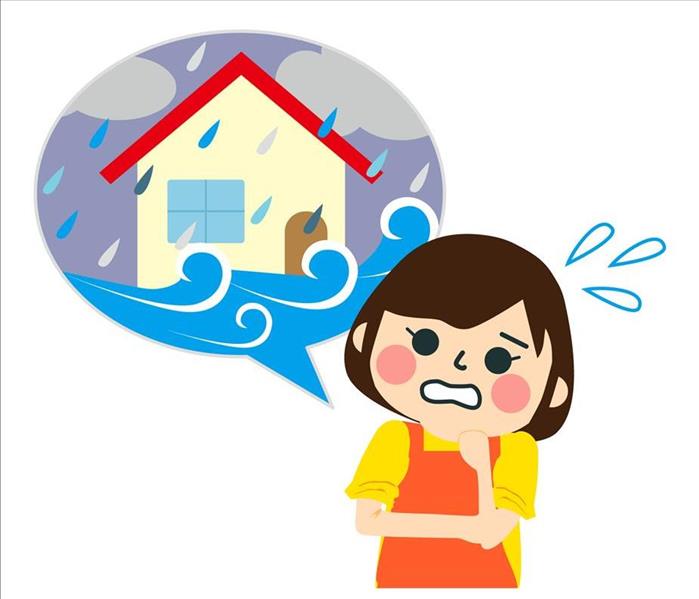How Can Flooded North Syracuse Properties Get Dried?
9/12/2020 (Permalink)
 Flood Damage in North Syracuse? Don't Fret! Call SERVPRO for Extraction and Restoration--We're Faster to Any Size Disaster!
Flood Damage in North Syracuse? Don't Fret! Call SERVPRO for Extraction and Restoration--We're Faster to Any Size Disaster!
After mitigation completes, several factors play a role in drying your flooded property.
Flooding is a situation that can strike quickly in North Syracuse, often following prolonged bouts of hard, torrential rain. With so many creeks and streams including Lake Onondaga, surrounding the city, many homes and businesses can be at risk for natural flooding. Fierce storms can also damage roofs, allowing direct rainfall and runoff to find its way into the property. Whatever kind of flood damage that your property faces, it is critical to get mitigation and drying completed as soon as possible to protect the residence.
Many tactics and practices make up flood restoration for North Syracuse properties, and these actions begin as soon as our technicians arrive at a damaged address. Because we anticipate storm losses here in Upstate New York, we stay prepared with stocked trailers loaded with our water restoration and drying equipment. Our industry-leading equipment is only part of the drying equation, however. To promote efficient moisture removal, technicians must control:
- Airflow
- Temperature
- Humidity
How Does Airflow Impact the Drying of a Property?
Air movement is an underappreciated aspect of drying beyond air movers that our professionals bring to a job site. There is a science behind air movement to find a balance between both temperatures and moisture content. Understanding the direction airflow is most likely to travel can help our technicians to develop the best drying plan with the appropriate placement of equipment like desiccant and low-grain refrigerant dehumidifiers (LGR.)
- Vapor Pressure – Regarding the natural movement of air in a house after water disasters have occurred, our technicians plan for properties to seek equilibrium of effects. Relative humidity between one area and another causes air to move to even these two spaces. Temperature can be another driving force in the air seeking equilibrium.
- Vapor Barriers – Minimal airflow on drying surfaces can allow cooling vapor barriers to form that restrict warmer temperatures beneficial to the drying process.
- Regulating Airflow – Air movers, both axial and centrifugal models, are instrumental in our SERVPRO professionals' drying process. Axial units work to circulate dry air through an open area, while centrifugal options are targeted at wet materials to promote faster drying in specific points.
Can Temperature Differences Impact Drying?
Temperatures of both the room and the affected materials can impact the effectiveness and efficiency of drying. Because it is vital to remove excess moisture trapped in materials as soon as possible, monitoring these temperature changes and varying conditions can help provide the best approach to recovering the house after a water disaster.
- Surface Drying – Evaporation can cool surfaces and form a barrier that restricts warm air from reaching the damaged material and continuing the drying process. We can determine when more direct airflow with our centrifugal air movers is necessary by recognizing these conditions with devices like infrared cameras.
- Cooling Concerns – Cooler room temperatures in the drying zones can also slow the evaporative process and make restoration longer. We can increase these enclosed work zones' temperatures to the desired warmth for the most efficient drying.
- Direct Heating – By warming surfaces with our equipment like portable electric heaters in drying zones, we can promote a faster evaporation time if technicians are careful not to over-dry structural elements.
Is Environmental Moisture a Factor in Drying?
The area where our technicians have formed a drying zone requires regulatory actions to reduce moisture. Higher humidity and moisture content in this area of the house can lead to slower drying times and ultimately cost customers more. There are three primary considerations when contending with changing humidity in drying zones, and these include:
- Vapor Pressures – Pressure from one saturated material to open areas forces moisture into otherwise dry or less humid environments.
- Relative Humidity – The measure of relative humidity is the moisture content in an environment. The higher this percentage, the more challenging that drying efforts can become, as evaporation slows. The more effective evaporative drying becomes the more equipment and processes required to reduce relative humidity.
- Regulating Moisture Content – The most efficient method of regulating and controlling the excessive humidity common to water disasters is dehumidification equipment. Desiccants introduce heated air back into the environment after pulling moisture out, encouraging more efficient evaporation and drying.
Multiple factors play a role in how efficient and thorough drying can be for your home or business. Despite the extensive inventory of recovery equipment, it is often the knowledge and experience of our SERVPRO of North Onondaga County team that has the most significant impact on providing a swift restoration process. Give us a call anytime that you need us at (315) 457-3432.






 24/7 Emergency Service
24/7 Emergency Service